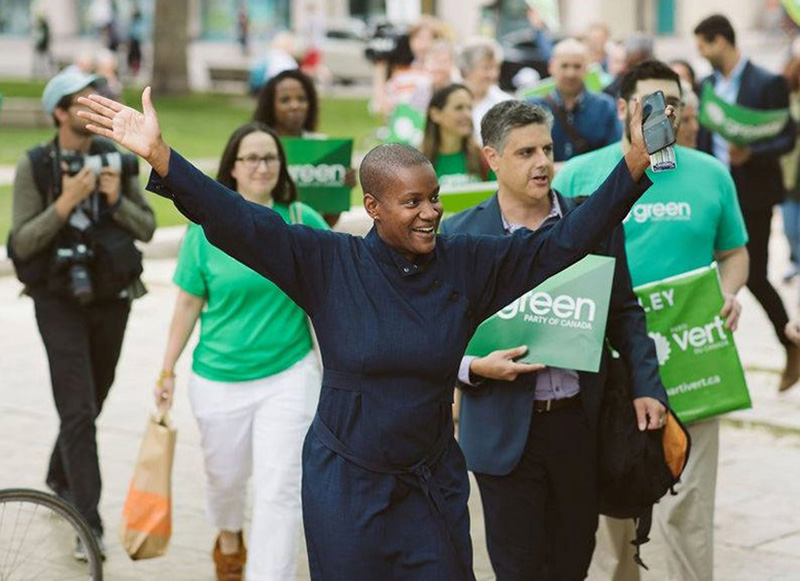
The tenure of Annamie Paul as leader of the Green Party of Canada was short. Paul is resigning as leader of the Green Party less than a year after she took over.
When Elizabeth May stepped down as leader in November 2019 after helming the party for 13 years, she left big shoes to fill. In the 2019 federal election, the party doubled its share of the popular vote compared to the previous election and obtained more than a million votes for the first time. Three Green Party members were elected as MPs, also a first.
Yet simmering below the surface were ideological, organizational and management divisions and strife. The different visions for the party showed up in the platforms of those vying to be the new leader. Indeed, the 2020 Green Party leadership race laid bare these deep ideological divides about how the Green Party should present itself in the future.
Several candidates ran on an eco-socialist platform and argued that capitalism is the root of climate change and inequality whereas others, including Paul, were seen as centrists “who represented the liberal establishment of the Green Party and a continuation of May’s pro-capitalist environmentalism.”
After eight rounds of voting, Paul won the leadership in October 2020.
Failed to win a seat
It was a bumpy start for Paul. She lost a byelection for the Toronto Centre riding later that month, which meant she wasn’t able to lead the Greens in the House of Commons. By April 2021, leaks were starting to pour into the media about internal strife within the party, including allegations the party was ineffective in dealing with issues involving sexism, racism and diversity.
In May and June 2021, the Green Party revisited an issue that had haunted them before. The Israeli-Palestinian conflict blew up the party, spurring MP Jenica Atwin to cross the floor to the Liberals because of Paul’s statement on the escalation of fighting in Gaza. Paul’s response to encourage the de-escalation of violence and to support peace in the area was seen to be “totally inadequate” from Atwin and others.
Paul’s senior adviser, Noah Zatzman, also publicly criticized Green MPs and other Green Party members for their pro-Palestinian stance. Many members were outraged that Paul didn’t publicly discipline Zatzman in some manner.
In June and July 2021, concerns about Paul’s leadership escalated. There was a call to vote on a measure of non-confidence in Paul’s leadership, a Federal Council (the governing body for the Green Party) motion to hold back campaign funds for Paul’s campaign in Toronto Centre and a move to revoke Paul’s membership in the Green Party.
Paul, the first Black and Jewish woman to lead a major federal party, has said efforts to push her out were fuelled by racism and sexism.
In a June meeting, Paul said the allegations made against her “were so racist, so sexist, that they were immediately disavowed by … our MPs as offensive and inflammatory.” And she said it was not an isolated incident, alleging the hatred escalated when she became leader. She called for efforts to stop the targeted attacks.
Election night results were a stark contrast from 2019. It became clear that Paul would either resign or endure a party non-confidence vote and leadership review. A week later, she stepped down.
Lessons for the Greens
While the Green Party should have learned many lessons over the past year, there are a few that particularly stand out.
While internal party turmoil happens in all political parties, loyalty to the party and its leader as issues and problems arise must be paramount instead of disgruntled members leaking stories to the media.
Rather than presenting itself as a professional party capable of leading the country, Canadians were treated to what seemed like a reality show that seriously eroded voter trust and confidence. It’s no wonder Paul described her leadership as the worst period in her life.
The Greens must also define their governance structure and cultural soul, including addressing the systemic barriers within the party in terms of equity, diversity and inclusion related to culture, race, language, gender, physical ability and religion.
Some members, like former leadership candidate Glenn Murray, have called for the party to figure out what it really stands for. Anna Keenan, Green candidate in Prince Edward Island, says the party should focus on a culture of team unity that is “struggling together towards the same goals, instead of struggling against each other.”
The party also has to come to terms with the role of the leader in the Green Party of Canada. In response to Paul’s resignation, May stated in an interview that the Greens leader is not the boss: “You’re the chief spokesperson,” she said. “You’re not the boss.” The question is whether future Green Party leadership candidates fully understand and accept this challenge.
The role of interim leader or caretaker is still being determined. Both May and Jo-Ann Roberts, a former journalist turned Green candidate, have steered the ship before and are being considered.
Other political parties have weathered internal storms. There are many Greens in Canada who are hoping the Green Party can do so too.
By:
Kimberly Speers Public Administration Teaching Professor, University of Victoria
Disclosure statement
Kimberly Speers has been a member of four different political parties at some point during her life. She has been non-partisan for almost twenty years and teaches in a manner that encourages critical thinking and that prepares students to work for a government of any political stripe.













